Food Waste Statistics for Ireland
EPA waste data release, 26th June 2025. Data reference year 2023. (Data subject to Eurostat validation).
This data release presents key statistics on food waste in Ireland in 2023.
Food waste is a global problem that has environmental, social and economic consequences. More than one quarter of the food produced globally is wasted. It is a significant contributor to climate change, as food loss and waste contribute to 8-10% of greenhouse gas emissions[1]. Growing, processing and transporting food all use significant amounts of resources such as land, water and energy.
The European Commission has provisionally agreed a general approach to introducing amendments to the Waste Framework Directive. These amendments propose the introduction of mandatory food waste reduction targets - a 10% reduction in food waste from processing & manufacturing and a 30% reduction from retail, restaurants, food services and households.
Further information on actions to prevent to food waste can be found at Stop Food Waste and the Food Waste Charter.
What is food waste?
The European Commission defines food waste as any food that becomes waste under the following conditions:
- It has entered the food supply chain (i.e. post harvesting)
- It then has been removed or discarded from the food supply chain, or at final consumption stage, and
- It is finally destined to be processed as waste
EU Member States are required to report the amount of food waste generated along the following stages of the food supply chain, see Figure 1.
Figure 1. Food Supply Chain
.jpeg)
How much food do we waste in Ireland?
The EPA estimates that Ireland generated 835,000 tonnes (t) of food waste[2][3] in 2023.
This equates to 162 kg of food waste per person and is higher than the EU average of 132 kg of food waste per capita[4].
Current food waste reporting obligations began in 2020. Between 2020 and 2022, a gradual downward trend was noted for Ireland’s total food waste estimates. However, there was an increase of 11% in the total estimated food waste in 2023. The manufacturing and processing sector makes up most of this increase. See paragraph on manufacturing and processing below for further information.
Food waste must be measured across five economic sectors of the supply chain and the figures for 2023 are given in table 1 and figure 2 below.
|
Food Supply Chain sector |
Tonnes of Food Waste |
Percentage of Total Food Waste |
Primary Production |
50,000 |
6% |
|
Manufacturing and Processing |
305,000 |
37% |
|
Retail and Distribution |
84,000 |
10% |
|
Restaurants and Food Service |
175,000 |
21% |
|
Households |
221,000 |
26% |
|
Total |
835,000 |
100% |
Table 1. Estimated Food Waste Generated in Ireland in 2023

Where does our food waste come from?
Households
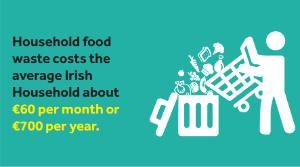
Irish households threw away an estimated 221,000 tonnes of food (26% of total) in 2023. This includes food waste collected from households, brought to civic amenity sites and disposed in home composters.
This is equal about 120 kg of food waste per household or 43 kg per person (that’s about half the weight of a full brown bin).
Food waste costs the average Irish household about €60 per month or €700 per year. That’s an annual national cost of €1.29 billion.
The organic waste bin (brown bin) roll out to households has increased the composting and anaerobic digestion rate of food waste. In 2023, 68% of Irish households who had a kerbside bin collection service had a brown bin (this includes households who share a bin).
Further information on the proportion of brown bin waste collected in each local authority area is presented on our Household waste statistics webpage.
Manufacturing and Processing

The food and beverage manufacturing and processing sector in Ireland generated an estimated 305,000 tonnes of food waste (37% of total) in 2023. This is an increase of nearly 33% or 75,000 T compared to 2022.
Food waste from this sector includes: foods unsuitable for consumption or processing (e.g. unsafe products or product returns), process wastes (e.g. wastes arising during processing & cleaning) and some animal tissues waste which are disposed as waste.
However, a significant proportion of animal tissue and other processing ‘wastes’ are processed into by-products such pet food, animal feed and fertiliser, and are therefore not counted as food waste in our statistics.
Food waste in this sector increased in 2023. This was in part due to an increase in tonnage of animal tissue waste, as well as an increase in food waste in biofuel production.
The increase in animal tissue waste was primarily linked to Ireland’s change from ‘controlled bovine spongiform encephalopathy (BSE) risk’ to ‘negligible BSE risk’ under Commission Implementing Decision (EU) 2021/1321. This meant that animal tissue which were previously deemed as high risk for suspected infection, and not counted within the food waste definition, were reclassified as low risk. This low-risk animal tissue could then be utilised for further processing, for example as animal by-products or in energy recovery, within the food supply chain. Outputs from processing these wastes include animal feed (not food waste) and biodiesel (food waste).
Overall, this increase in animal tissue waste entering the scope of food waste reporting has resulted in a large increase in food waste tonnages for the manufacturing and processing sector in 2023.
Restaurants and Food Services
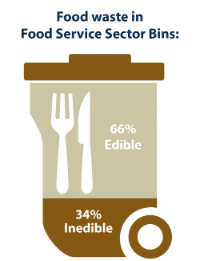
Restaurants and food services generated approximately 175,000 tonnes of food waste (21% of total) in 2023. This sector includes food waste collected from hotels, B&Bs, pubs and restaurants, cafes, takeaways and canteens
The Reducing Commercial Food Waste in Ireland report published in 2019, found that over 66% of food waste from the food services sector is avoidable (i.e. edible food). It found that hotels have the highest level of food waste and vegetables are the most commonly wasted food type (11%), followed by bread (9%), meat (8%) and potatoes (7%).
Primary Production
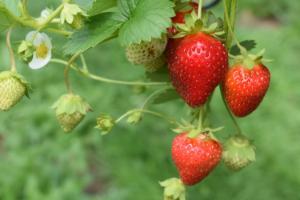
An estimated 50,000 tonnes of food waste (6% of total) was generated at the primary production stage in Ireland in 2023.
Of this, horticulture accounted for the largest share. Some of the main cause of food waste at the primary production stage is that products are not saleable as outside quality specifications or lack of customer demand.
Further information on the nature and extent of food loss and waste from primary production in Ireland is provided in the EPA funded research report Food Loss and Waste from Farming, Fishing & Aquaculture in Ireland published in 2022.
Retail and Distribution
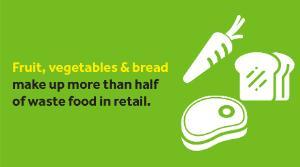
The retail and distribution sector accounted for approximately 84,000 tonnes of food waste (10% of total) in 2023.
This sector includes food waste from supermarkets and smaller grocery shops, service stations and general retail, as well as food waste generated by food & beverage wholesale companies.
Retailers may dispose of food products which are spoiled or damaged. An EPA-funded research report on Reducing Commercial Food Waste in Ireland published in 2019 found that vegetables are the most commonly wasted food type in supermarkets (20%), followed by fruit (16%), bread (15%) and meat (11%).
Some surplus food from retailers is redistributed to help feed people which prevents the food from becoming waste. Food Cloud redistributed 1,608 tonnes of surplus food from this sector in 2023 to charities which help feed people living in food poverty.
How do we reduce food waste?
Food Waste Prevention
In line with the food waste hierarchy (Figure 3 below), prevention is the best way to address food waste. A National Food Waste Prevention Roadmap was published by the Irish Government in 2022 with details of actions to halve Ireland’s food waste by 2030.
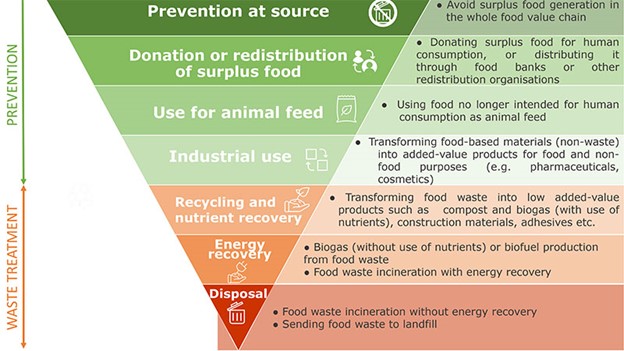
Robust and consistent measurement of food waste is the first step in food waste prevention, as it provides quality data to monitor of food waste generation, support food waste prevention initiatives and report on progress to reduction targets.
The EPA’s food waste prevention programme is implemented through the Agency’s Circular Economy Programme. It aims to raise awareness of food waste and target behavioural change through a number of activities including:
- Stop Food Waste which is a national campaign to reduce household food waste.
- Food Waste Charter which is a public commitment by companies and organisations to recognise and address the issue of food waste.
- Food Waste Protocol for Manufacturing Sector to support food and drink manufacturers to identify and quantify their food waste streams and put in place actions to reduce their food waste.
- Food Service Pathway for Hospitality Sector which is a four-step pathway for businesses to estimate food waste in a consistent way, track performance & identify how to reduce food waste.
Learn more about food waste prevention on our dedicated webpage.
Redistribution of surplus food
After prevention, redistribution of surplus food is the next preferred option in the Food Use Hierarchy (Figure 3) and is an important way to avoid food becoming waste and to support charities who help feed people living in food poverty. In 2023, Food Cloud redistributed a total of 3,723 tonnes of food donated by Irish food producers, distributers and retailers, supporting 685 community groups.
Management of food waste
Even if all ‘avoidable’ food waste was eliminated entirely, there will still be a need to manage ‘unavoidable’ food waste such as peel, bones and animal tissue. Therefore, it is important to ensure any food waste that arises is segregated and separately collected so that it can be treated by composting or anaerobic digestion (Figure 3), rather than being mixed general waste and disposed to landfill or incinerated.
Ireland’s implementation of the Food Waste Regulations since 2010 and the associated roll out of brown bins to commercial and household premises, along with associated awareness raising activities to promote better segregation, have contributed to an upward trend in the quantity of food waste being separately collected and treated by composting/anaerobic digestion.
However, there is still room for improvement as a large proportion of Ireland’s food waste continues to be disposed of in mixed waste bins. EU waste legislation means that the separate collection of biowaste has been mandatory from the beginning of 2024.
Further information on composting/anaerobic digestion and biodegradable municipal waste sent to landfill can be found on our Waste Statistics webpages.
References
[1] During 2010-2016, global food loss and waste contributed 8-10% of total anthropogenic GHG emissions(medium confidence).” Source: (Climate Change and Land: an IPCC special report on climate change, desertification, land degradation, sustainable land management, food security, and greenhouse gas fluxes in terrestrial ecosystems, (2019)) https://www.ipcc.ch/srccl/.
[2] Under the revised Waste Framework Directive (2008/98/EC) and Implementing Decision (EU) 2019/2000, EU Member States are obliged to report the amount of food waste generated on an annual basis from reference year 2020. The Irish Food Waste Statistics for 2022 have been collated in accordance with the food waste reporting methodology is laid out in Commission Delegated Decision (EU) 2019/1597 (2019) and the reporting format is defined in Commission Implementing Decision (EU) 2019/2000 (2019).
[3]European Commission, Eurostat (June, 2022) Guidance on reporting of data on food waste and food waste prevention according to Commission implementing Decision (EU) 2019/2000
[4] Based on Eurostat figure for EU inhabitants in 2022. https://ec.europa.eu/eurostat/statistics-explained/index.php?title=Food_waste_and_food_waste_prevention_-_estimates
To see data from previous years see: Food Waste Data Archive | Environmental Protection Agency (epa.ie)